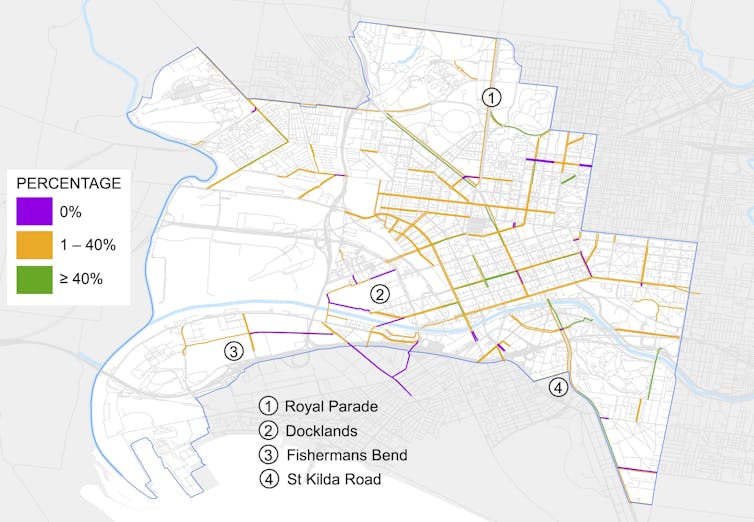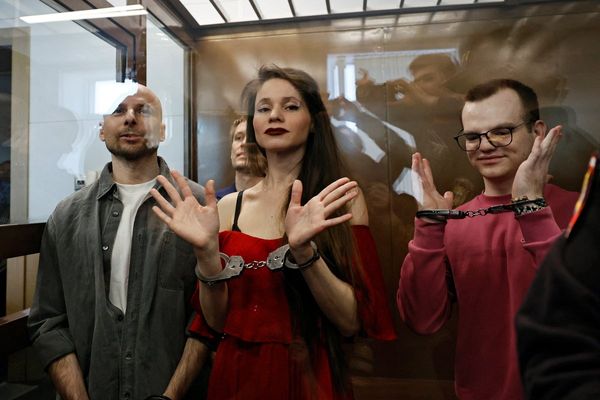
Walking and cycling is good for people and the planet. But hot sunny days can make footpaths, bike lanes and city streets unbearable. Climate change will only make matters worse.
So city planners and decision-makers need to provide adequate shade for walking, cycling and other forms of active transport – including from good tree canopy cover.
Unfortunately, our recent research reveals Melbourne’s transport strategy and its separate strategy to increase canopy cover from 22% to 40% by 2040 aren’t currently working together.
Our research found most bicycle lanes in inner Melbourne today have less than 40% canopy cover. And as the maps below show, future bicycle lanes will have even less. There’s plenty of room for improvement.
Searching for shady lanes
We used the City of Melbourne as a case study to explore bikeability, tree cover and health.
The city council area covers 37 square kilometres, taking in suburbs from leafy Parkville to industrial Fishermans Bend.
When we mapped tree canopy cover against the active transport network, we found most bicycle lanes have less than 40% canopy cover. Some cycling corridors – such as along Royal Parade and parts of St Kilda Road – stand out with relatively high canopy cover. But they are few and far between.
Existing bike lanes

And it’s about to get worse.
Bicycle lanes proposed for construction have lower overall tree canopy coverage than existing lanes, particularly in urban renewal areas in post-industrial precincts such as Fishermans Bend and Docklands.
Along Royal Parade and St Kilda Road corridors, additional bicycle lanes are proposed next to existing lanes. However, in current conditions, the proposed new bicycle lanes have lower canopy coverage than existing bicycle lanes along the same corridor.
Proposed bike lanes

The city’s strategies don’t match up
We also examined the city’s transport and urban forest strategies. The latter includes the council’s ambitious goal to increase canopy cover to 40% by 2040.
We found both the transport and urban forest policies recognise that they can contribute to the health and wellbeing of city residents, workers and visitors. They also acknowledge the health risks associated with lack of physical activity, such as heart disease, lung disease and diabetes. But there are key gaps.
The transport strategy broadly refers to climate change, but does not mention urban heat.
In contrast, addressing urban heat is one of the main stated aims of the urban forest strategy. But there’s only a passing reference to encouraging outdoor activity and exercise.
There are signs though that this may be changing – in 2022, Melbourne has joined a handful of other cities worldwide in appointing chief heat officers to focus planning and action for cooler cities.
Planning for more trees
Trees need sufficient space for healthy growth. This includes space below ground for a strong and stable root system as well as room to grow up and spread out.
For street trees, extra care must be taken to facilitate this growth. The locations of other infrastructure, both above- and below-ground, need to be taken into account.
Smaller trees may be more appropriate in some urban areas, particularly where overhead powerlines require clearance, but obviously these trees will provide less canopy. Likewise, healthy tree root development can be disrupted by underground services, unless high quality soil and sufficient space is allocated.
To ensure trees are still thriving in 50 or even 100 years time, planners also need to select species that can withstand hotter and drier conditions.
What a difference shade makes
Street trees cool urban areas by shading surfaces and releasing water into the air. This can lower air temperatures by 1-2°C. But the temperature difference on the ground can be even more substantial. Asphalt can be anywhere from 13°C–20°C cooler under dense tree canopy shade.
Reducing the amount of heat roads and other hard surfaces absorb eases what’s known as the urban heat island effect, in which cities experience warmer temperatures than green spaces.
Climate change is increasing the frequency and duration of heatwaves. This adds to the pressure on Australia’s health services, including ambulances and emergency departments. If current rates of climate change continue, Victorians are likely to experience twice the annual number of very hot days by the 2050s, compared with 1985-2005.
All of this means walking or riding in the absence of shade can expose people to heat-related illness and even premature death.

Better planning for liveable cities
Our research shows planning policies must work together more effectively for liveable cities. This is particularly important when it comes to building new infrastructure such as roads, bicycle lanes and footpaths.
Proactively planning for more trees in these spaces can promote healthy tree growth, with benefits for human health in cooler cities.
And while we can plant trees next to bike lanes for future shade, the need to protect cyclists from heat now means we should locate bike lanes along existing shaded streets.
City planners and decision-makers need to ensure the places we live, work and play are designed to promote active transport. That means ensuring transport routes align with our urban forest.
Acknowledgements: thanks to Bachelor of Design, Urban Planning (Honours) student Crystal Tang who carried out the research that underpins this article.
Judy Bush is the recipient of a Discovery Early Career Researcher Award (2024-27) from the Australian Research Council. She is a member of the Planning Institute of Australia and the Ecological Society of Australia. Crystal Tang undertook the data collection and analysis as part of her B.Des (Hons), supervised by Judy.
This article was originally published on The Conversation. Read the original article.







